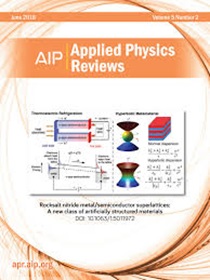Interface engineering for low-voltage operation of organic light-emitting diodes
IF 11.9
1区 物理与天体物理
Q1 PHYSICS, APPLIED
引用次数: 0
Abstract
Organic light-emitting diodes (OLEDs) have been studied intensively, and their practical applications are advancing. The efficiency of light-emitting materials has been improved significantly through the understanding of their emission mechanisms. However, the correlation between the bandgap of the emitter and the operating voltage in OLEDs remains unclear, because OLEDs require a complex multilayer configuration that includes many materials other than the emitter. It is difficult to investigate the exact energy diagram for OLEDs, which have many interfaces, and many uncertainties remain regarding the mechanisms of charge injection and recombination. In this review, we introduce both the charge injection and recombination mechanisms in OLEDs and the interface control technology effective for lowering their operating voltage. We explain the electron injection mechanism at organic/cathode interfaces, which is clarified by using organic bases as the electron injection layers. The hole injection mechanism in OLEDs, which is clarified by investigating the correlation between the characteristics of OLEDs and the actual energy levels at organic/anode interfaces, is also introduced. With the elucidation of the charge injection mechanism, holes and electrons can now be injected into various organic materials. These charge injection techniques minimize the voltage required for charge recombination. The correlation between the bandgap of the emitter and the minimum voltage required for OLED operation is clarified by controlling the energy levels at organic/organic interfaces. Understanding this correlation enables the design of molecules for ultralow-voltage OLEDs, thereby realizing blue OLEDs with an extremely low turn-on voltage of about 1.5 V.求助全文
约1分钟内获得全文
求助全文
来源期刊

Applied physics reviews
PHYSICS, APPLIED-
CiteScore
22.50
自引率
2.00%
发文量
113
审稿时长
2 months
期刊介绍:
Applied Physics Reviews (APR) is a journal featuring articles on critical topics in experimental or theoretical research in applied physics and applications of physics to other scientific and engineering branches. The publication includes two main types of articles:
Original Research: These articles report on high-quality, novel research studies that are of significant interest to the applied physics community.
Reviews: Review articles in APR can either be authoritative and comprehensive assessments of established areas of applied physics or short, timely reviews of recent advances in established fields or emerging areas of applied physics.
 求助内容:
求助内容: 应助结果提醒方式:
应助结果提醒方式:


